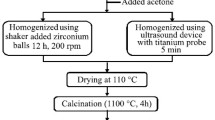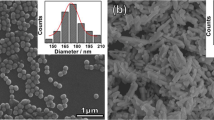Abstract
Barium titanate ceramics were prepared using the nanopowder resulting from a polymeric precursor method, a type of modified Pechini process. The obtained nanopowder was observed to agglomerate and in order to de-agglomerate the powder and enhance the properties of the barium titanate the material was attrition milled. The impact of this attrition milling on the electrical properties of the barium titanate was analysed. The temperature dependence of the relative dielectric permittivity showed three structural phase transitions that are characteristic for ferroelectric barium titanate ceramics. The relative dielectric permittivity at the Curie temperature was higher for the attrition-treated sample than for the non-treated barium titanate. The dielectric losses were below 0.04 in both barium titanate ceramics. The grain and grain-boundary contributions to the total resistivity were observed using impedance analyses for both ceramics. A well-defined ferroelectric hysteresis loop and piezoelectric coefficient d33 = 150 pC/N were obtained for the ceramics prepared from the de-agglomerated powder. In this way we were able to demonstrate that by attrition milling of chemically obtained powders the ferroelectric and piezoelectric properties of the ceramics could be enhanced.






Similar content being viewed by others
References
Jona F, Shirane G (1993) Ferroelectric crystals. Dover Publications, New York
Moulson AJ, Herbert JM (2003) Electroceramics, 2nd edn. Wiley, England
Shiau FS, Fang TT, Leu TH (1998) Effects of milling and particle size distribution on the sintering behavior and the evolution of the microstructure in sintering powder compacts. Mater Chem Phys 57:33–40
Tusseau-Nenez S, Ganne JP, Maglione M, Morell A, Niepce JC, Pate M (2004) BST ceramics: effect of attrition milling on dielectric properties. J Eur Ceram Soc 24:3003–3011
Pechini MP, Adams N (1967) United States patent No 3, 330, 697
Ramajo L, Parra R, Roboredo M, Zaghete M, Castro M (2008) Heating rate and temperature effect on the BaTiO3 formation by thermal decomposition of (BaTi) organic precursors during the pechini process. Mat Chem Phys 107:110–114
Vijatović Petrović MM, Bobić JD, Radojković AD, Banys J, Stojanović BD (2012) Improvement of barium titanate properties induced by attrition milling. Ceram Inter 38:5347–5354
Dabhade VV, Rama Mohan TR, Ramakrishnan P (2007) Nanocrystalline titanium powders by high energy attrition milling. Powder Technol 171:177–183
Thakur OP, Prakash C, James AR (2009) Enhanced dielectric properties in modified barium titanate ceramics through improved processing. J Alloys Compd 470:548–551
Horchidan N, Ianculescu A, Curecheriu L, Tudorache F, Musteata V, Stoleriu S, Dragan N, Grisan D, Tascu S, Mitoseriu L (2011) Preparation and characterization of barium titanate stannate solid solutions. J Alloys Compd 509:4731–4737
Vijatovic Petrovic MM, Bobic JD, Ramoska T, Banys J, Stojanovic BD (2011) Antimony doping effect on barium titanate structure and electrical properties. Ceram Int 37:2669–2677
West AR, Sinclair DC, Hirose N (1997) Characterization of electrical materials, especially ferroelectrics by impedance spectroscopy. J Electroceram 1(1):65–71
Devi S, Jha AK (2009) Phase transition and electrical characteristics of tungsten substituted barium titanate. Physica B 404:4290–4294
Thakur OP, Feteira A, Kundys B, Sinclair DC (2007) Influence of attrition milling on the electrical properties of undoped-BaTiO3. J Eur Ceram Soc 27:2577–2589
Sinclair DC, West AR (1989) Impedance and modulus spectroscopy of semiconducting BaTiO3 showing positive temperature coefficient of resistance. J Appl Phys 66:3850–3856
Jaffe B, Cook WR, Jr, Jaffe H (1971) Piezoelectric ceramics. Academic press, London
Sonia Patel RK, Kumar P, Prakash C, Agrawal DK (2012) Low temperature synthesis and dielectric, ferroelectric and piezoelectric study of microwave sintered BaTiO3 ceramics. Ceram Int 38:1585–1589
Chandramani Singh K, Nath AK (2011) Barium titanate nanoparticles produced by planetary ball milling and piezoelectric properties of corresponding ceramics. Mater Lett 65:970–973
Thakur OP, Prakash C, Agrawal DK (2002) Structural and electrical properties of microwave-processed BaTiO3 ceramics. J Ceram Process Res 3:75–79
Shao S, Zhang J, Zhang Z, Zheng P, Zhao M, Li J, Wang C (2008) High piezoelectric properties and domain configuration in BaTiO3 ceramics obtained through the solid-state reaction route. J Phys D Appl Phys 41:125408
Takahashi H (2012) Development of Lead-Free BaTiO3 ceramics possessing enhanced piezoelectric properties. Electron Commun Jpn 95([4):1168–1173
Acknowledgments
The authors gratefully acknowledge the Ministry of Education, Science and Technological Development of the Republic of Serbia for the financial support of this work (projects III45021) and the COST MP0904 Action SIMUFER: “Single- and multiphase ferroics and multiferroics with restricted geometries”. Special thanks to Dr Paul Bowen from EPFL, Lausanne, Switzerland for generous research support. Technical support by David Žehelj from JSI is gratefully acknowledged. H. Uršič thanks the Slovenian Research Agency for the financial support in the frame of programs Electronic Ceramics, Nano-, 2D and 3D Structures (P2-0105).
Author information
Authors and Affiliations
Corresponding author
Rights and permissions
About this article
Cite this article
Vijatović Petrović, M.M., Bobić, J.D., Uršič, H. et al. The electrical properties of chemically obtained barium titanate improved by attrition milling. J Sol-Gel Sci Technol 67, 267–272 (2013). https://doi.org/10.1007/s10971-013-3075-9
Received:
Accepted:
Published:
Issue Date:
DOI: https://doi.org/10.1007/s10971-013-3075-9




